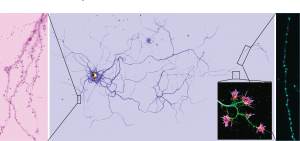Our fascination and main research focus concerns the beautiful but complicated shape of individual neurons, and the complex intracellular logistics required to form, maintain and remodel these cells throughout life.

Neurons extend processes that cover vast territories, which allow them to directly connect with cells distant from the soma, with each individual neuron forming thousands of connections. Our research interest is to understand how neurons integrate the different extracellular cues that they receive at distinct parts of the cell in time and space to maintain and adapt their structure and connectivity. To this end, we study the interplay of short- and long-range trafficking and signalling, and how these events ultimately converge to initiate changes in neuronal morphology and physiology.
The formation and maintenance of neuronal connections requires morphological changes and is tightly coupled to activity-dependent events. In this regard, the neurotrophin BDNF provides an example of a highly regulated growth factor that triggers intracellular processes to initiate changes in cell shape. Moreover, its precursor, proBDNF, is also biologically active with largely opposing actions to those of mature BDNF, thus allowing for tightly controlled, bi-directional modulation of neuronal morphology by a single growth factor. We investigate how BDNF shapes neurons in health and disease.
In neurodegeneration, the axon becomes compromised and axonal transport breaks down. Using models of tauopathy and synaptopathy we explore how growth factors signal during different stages of degeneration, in response to different challenges. We further investigate how the neuron detects, and reacts to, distal axonal stresses such as dysfunctional proteostasis.

Finally, we are interested in the cell biology underlying propagation of pathogenic material across neuronal circuits. We investigate how cytosolic protein aggregates form within a neuron and spread to its neighbouring cells. Our current focus is on the formation and propagation of pathogenic tau.
We thank the following funding bodies for supporting our work: